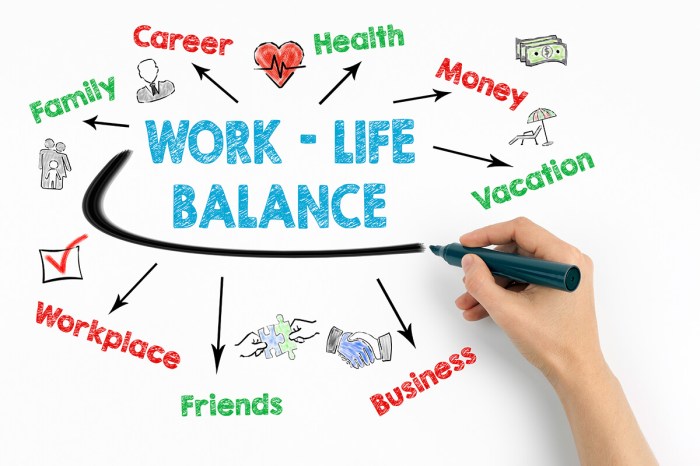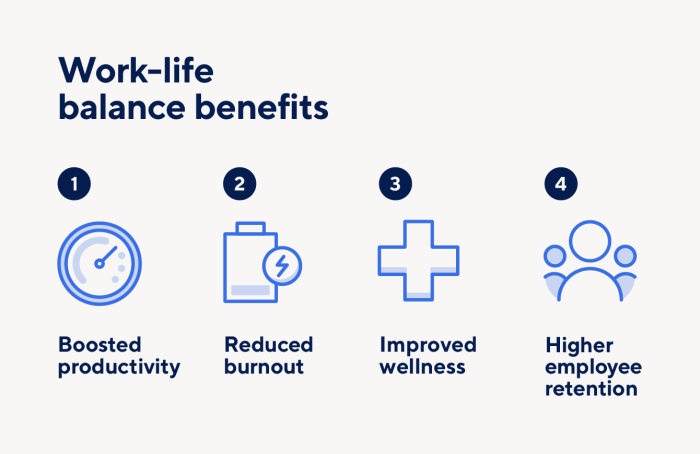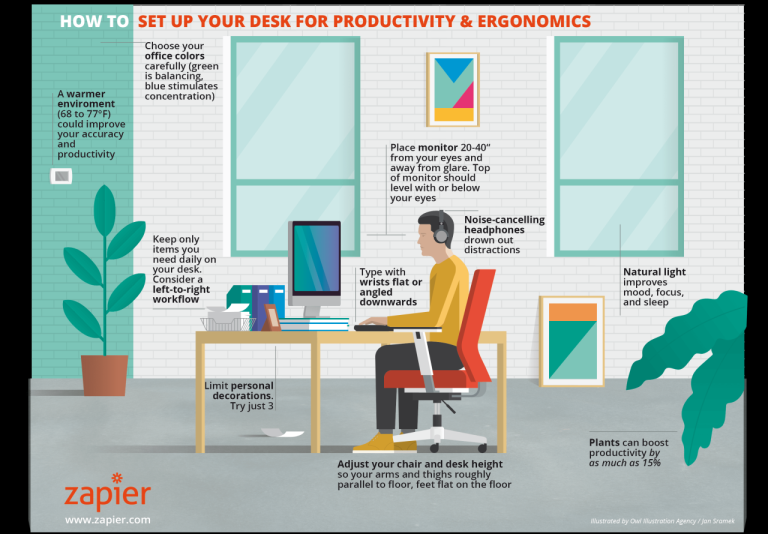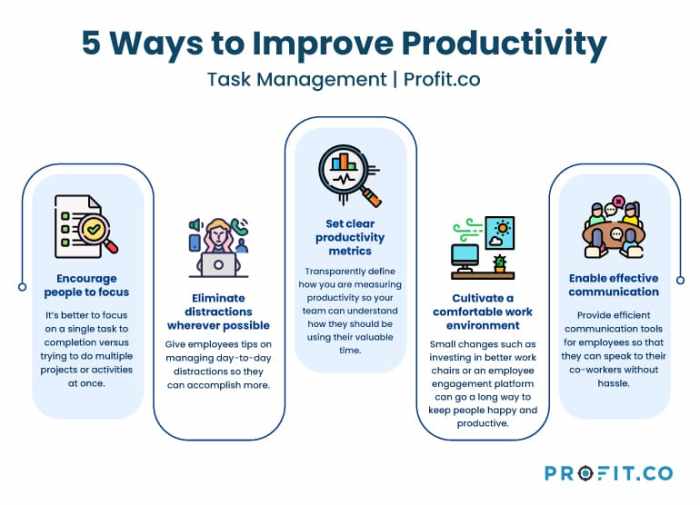
The pursuit of a fulfilling life often involves navigating the delicate balance between work and personal time. Finding harmony in this dynamic duo is crucial for both our well-being and our productivity. This exploration delves into practical strategies and insightful perspectives to help you create a work-life balance that fosters both personal growth and professional success.
From setting boundaries and prioritizing tasks to leveraging technology and embracing mindfulness, we’ll uncover techniques that empower you to reclaim control of your time and create a lifestyle that nourishes your mind, body, and spirit. Whether you’re striving for greater efficiency in your professional life or seeking more time for personal pursuits, the principles Artikeld here can guide you toward a more balanced and fulfilling existence.
Understanding the Value of Work-Life Balance
In today’s fast-paced world, it’s easy to get caught up in the hustle and grind, prioritizing work over everything else. However, neglecting work-life balance can have detrimental effects on your well-being and productivity in the long run. A healthy work-life balance is crucial for achieving a fulfilling life, both professionally and personally.
The Importance of Work-Life Balance for Individual Well-Being and Productivity
A balanced life is essential for both your physical and mental health. When you prioritize work-life balance, you’re essentially investing in yourself, which can lead to increased productivity, creativity, and overall well-being. Here are some key benefits:
- Reduced Stress and Anxiety: Constant work pressure can lead to burnout, anxiety, and even depression. Having a healthy work-life balance allows you to de-stress and recharge, reducing the risk of these mental health issues.
- Improved Physical Health: When you’re constantly working, you may neglect your physical health, leading to unhealthy habits like poor sleep, lack of exercise, and unhealthy eating. A balanced life encourages you to prioritize your physical well-being through regular exercise, healthy eating, and adequate sleep.
- Enhanced Creativity and Innovation: When your mind is refreshed and free from work-related stress, you’re more likely to think outside the box and come up with innovative ideas. This can lead to improved problem-solving skills and increased creativity in your work.
- Increased Productivity: While it might seem counterintuitive, taking time for yourself can actually boost your productivity. A balanced life allows you to focus better on work when you’re at the office, as you’re not carrying the weight of stress and exhaustion.
The Potential Consequences of Neglecting Work-Life Balance
Ignoring the importance of work-life balance can have serious consequences for your health, well-being, and career. Here are some potential outcomes:
- Burnout: Constant overwork and stress can lead to burnout, characterized by emotional exhaustion, cynicism, and feelings of detachment from your work.
- Health Problems: Neglecting your physical health can lead to various health problems like heart disease, obesity, and sleep disorders.
- Decreased Productivity: When you’re constantly stressed and exhausted, your productivity suffers. You may find it difficult to concentrate, make decisions, and complete tasks effectively.
- Relationship Issues: A lack of work-life balance can strain your relationships with family, friends, and partners. You may find yourself spending less time with loved ones, leading to feelings of resentment and isolation.
- Job Dissatisfaction: When you feel constantly overworked and undervalued, it can lead to job dissatisfaction and even a desire to quit.
Examples of How Work-Life Balance Can Contribute to a Fulfilling Life
A healthy work-life balance can lead to a more fulfilling life, allowing you to pursue your passions and enjoy meaningful experiences outside of work. Here are some examples:
- Spending Quality Time with Family and Friends: A balanced life allows you to dedicate time to building and nurturing relationships with loved ones.
- Pursuing Hobbies and Interests: You can dedicate time to activities that bring you joy and fulfillment, whether it’s painting, playing music, or volunteering.
- Traveling and Exploring New Places: Having a balanced life gives you the freedom to explore new cultures and broaden your horizons.
- Improving Your Physical and Mental Well-being: You can invest time in activities that promote your physical and mental health, such as exercise, meditation, or spending time in nature.
Setting Boundaries and Prioritization
Setting clear boundaries between work and personal life is crucial for maintaining a healthy work-life balance. It helps you to avoid burnout and maintain a healthy lifestyle. Effective prioritization allows you to focus on the most important tasks, ensuring you are productive and efficient.
Setting Boundaries
Creating clear boundaries is essential for protecting your personal time and energy. Here are some effective strategies:
- Establish a dedicated workspace: Designate a specific area for work, ideally separate from your living space. This creates a mental separation between work and personal time.
- Set clear work hours: Stick to a regular schedule and avoid working late into the night or on weekends unless absolutely necessary. This allows you to have structured time for personal activities.
- Use technology to your advantage: Utilize tools like email filters, calendar reminders, and “Do Not Disturb” modes on your phone to minimize distractions during non-work hours.
- Communicate your boundaries: Inform colleagues and clients about your availability and expectations regarding work hours. This helps set expectations and avoids misunderstandings.
Prioritizing Tasks
Effective prioritization is key to managing your time and energy effectively. Here are some techniques:
- The Eisenhower Matrix: This method categorizes tasks based on urgency and importance. Focus on urgent and important tasks first, then move on to less urgent but important tasks.
- The Pareto Principle (80/20 rule): This principle suggests that 80% of results come from 20% of efforts. Identify the most impactful tasks and focus your energy on those.
- Time Blocking: Allocate specific time slots for different tasks or activities. This helps you stay focused and avoid multitasking.
Delegating Tasks
Delegating tasks to others is a valuable strategy for improving efficiency and freeing up your time. Here are some tips:
- Identify tasks that can be delegated: Assess tasks that can be effectively handled by others, allowing you to focus on more strategic activities.
- Choose the right person for the job: Select individuals with the skills and experience needed to complete the task successfully.
- Provide clear instructions and expectations: Ensure the delegate understands the task, its importance, and the desired outcome.
- Trust and empower: Give the delegate the autonomy to complete the task, providing support and guidance when needed.
Productivity Techniques for a Healthier Work-Life Balance
Once you’ve established a strong foundation of understanding your work-life balance needs, setting boundaries, and prioritizing your tasks, it’s time to dive into specific productivity techniques that can help you achieve that balance. These techniques are designed to enhance your efficiency and effectiveness while ensuring you have the time and energy for personal pursuits.
Deep Work and Its Benefits
The concept of “deep work,” coined by Cal Newport, emphasizes the importance of focused, uninterrupted work sessions. It involves immersing yourself in a task, free from distractions, to achieve a state of high concentration and productivity. This type of work allows you to tackle complex problems, generate creative ideas, and produce high-quality output.
The benefits of deep work are numerous:
- Increased Productivity: By eliminating distractions, you can complete tasks faster and with higher quality.
- Improved Creativity: Deep focus allows your mind to wander freely and generate innovative solutions.
- Enhanced Learning: When you concentrate deeply, you absorb information more effectively and retain it longer.
- Reduced Stress: Deep work can create a sense of accomplishment and reduce the anxiety associated with multitasking and feeling overwhelmed.
Minimizing Distractions and Maximizing Focus
To achieve deep work, you need to create an environment that minimizes distractions and maximizes focus. Here are some techniques:
- Schedule Dedicated Work Time: Block out specific time slots in your calendar for deep work, and treat these appointments as non-negotiable.
- Eliminate Physical Distractions: Turn off notifications, silence your phone, and find a quiet workspace free from interruptions.
- Use Tools to Block Distractions: Utilize apps like Freedom, StayFocusd, or Cold Turkey to temporarily block distracting websites and social media platforms.
- Practice the Pomodoro Technique: This method involves working in 25-minute intervals, followed by a 5-minute break. It helps maintain focus and prevents burnout.
- Prioritize Tasks: Focus on completing the most important tasks first, using techniques like the Eisenhower Matrix or the Pareto Principle.
Incorporating Breaks and Physical Activity
While deep work is essential, it’s equally important to incorporate breaks and physical activity into your workday to maintain your energy levels and prevent burnout. Here’s how:
- Take Regular Breaks: Step away from your desk every hour or so to stretch, walk around, or engage in a brief relaxation technique.
- Schedule Time for Exercise: Even a short walk or a quick workout can boost your mood, improve focus, and reduce stress.
- Prioritize Sleep: Aim for 7-8 hours of quality sleep each night to ensure you’re well-rested and ready to tackle your workday.
- Practice Mindfulness: Engage in mindfulness exercises or meditation to reduce stress, improve focus, and enhance overall well-being.
Mindfulness and Stress Management

Mindfulness plays a crucial role in managing stress and promoting overall well-being. By bringing awareness to the present moment without judgment, mindfulness helps us to detach from our worries and anxieties, fostering a sense of calm and clarity.
The Role of Mindfulness in Stress Management
Mindfulness allows us to observe our thoughts and feelings without getting carried away by them. It helps us to identify stress triggers and develop healthier coping mechanisms. By focusing on the present moment, we can interrupt the cycle of negative thoughts and emotions that often fuel stress.
Mindfulness Techniques for Daily Life
Incorporating mindfulness techniques into our daily routines can significantly reduce stress and improve our overall well-being. Here are some practical techniques:
- Mindful Breathing: Take a few minutes each day to focus on your breath. Pay attention to the sensation of each inhale and exhale, noticing the rise and fall of your chest or abdomen. This simple practice can help to calm your mind and reduce stress.
- Body Scan Meditation: Bring your attention to different parts of your body, starting from your toes and moving upwards. Notice any sensations, such as warmth, tingling, or pressure. This technique can help to release tension and improve body awareness.
- Mindful Walking: While walking, pay attention to the sensations of your feet on the ground, the movement of your body, and the sights and sounds around you. This practice can help to ground you in the present moment and reduce racing thoughts.
Benefits of Exercise and Relaxation Practices
Regular exercise and relaxation practices are essential for managing stress. Exercise releases endorphins, which have mood-boosting effects and help to reduce stress hormones. Relaxation practices, such as yoga, meditation, and deep breathing, can calm the nervous system and promote a sense of peace.
- Regular Exercise: Aim for at least 30 minutes of moderate-intensity exercise most days of the week. Activities like brisk walking, swimming, cycling, or dancing can help to reduce stress and improve overall well-being.
- Relaxation Techniques: Incorporate relaxation practices into your daily routine. Yoga, meditation, deep breathing exercises, or progressive muscle relaxation can help to calm your mind and body, reducing stress and promoting relaxation.
Leveraging Technology for Productivity and Balance
Technology has become an indispensable tool for modern professionals, offering a plethora of opportunities to enhance productivity and achieve a healthier work-life balance. However, it’s crucial to harness technology strategically, ensuring it serves as a catalyst for efficiency rather than a source of distraction or overwhelm.
Utilizing Productivity Tools and Apps
Technology offers a wealth of tools and apps designed to streamline work processes and minimize time spent on mundane tasks. These tools can help you manage your time effectively, prioritize tasks, and stay organized.
- Task Management Apps: Tools like Asana, Trello, and Todoist allow you to create project boards, assign tasks, set deadlines, and track progress. They provide a centralized platform for managing your workload and ensure that no task slips through the cracks.
- Calendar and Scheduling Apps: Google Calendar, Outlook Calendar, and Apple Calendar help you schedule meetings, appointments, and deadlines, keeping you organized and on top of your commitments. These apps also allow you to set reminders, preventing you from missing important events.
- Time Tracking Software: Time tracking apps like Toggl Track, Clockify, and RescueTime provide insights into how you spend your time, allowing you to identify areas for improvement and optimize your workflow. This data can help you allocate your time more effectively and avoid time-wasting activities.
- Communication and Collaboration Tools: Slack, Microsoft Teams, and Zoom facilitate seamless communication and collaboration with colleagues, regardless of location. These platforms enable efficient project discussions, file sharing, and virtual meetings, fostering a more productive and connected work environment.
Automating Tasks and Minimizing Time Spent on Non-Essential Activities
Technology can automate repetitive tasks, freeing up your time for more strategic and fulfilling activities.
- Email Automation: Use email automation tools like Mailchimp or Zapier to create automated email sequences for tasks like welcome messages, follow-ups, and reminders. This reduces manual effort and ensures consistent communication.
- Social Media Scheduling: Platforms like Hootsuite and Buffer allow you to schedule social media posts in advance, saving you time and ensuring consistent content delivery. This frees up your time to focus on creating high-quality content rather than constantly managing your social media presence.
- Document Templates: Create templates for frequently used documents, such as emails, reports, and presentations. This eliminates the need to start from scratch each time, saving you valuable time and effort.
Avoiding the Pitfalls of Technology Overuse
While technology can be a powerful tool for productivity and balance, it’s crucial to be mindful of potential pitfalls.
- Distractions: Constant notifications, social media updates, and emails can be major distractions, hindering your focus and productivity. Implement strategies like turning off notifications, using website blockers, and setting dedicated work hours to minimize distractions.
- Screen Time: Excessive screen time can lead to eye strain, headaches, and sleep disturbances. Practice regular breaks, use blue light filters, and ensure your workspace is ergonomically designed to minimize the negative impacts of screen time.
- Digital Overload: The constant influx of information and stimuli can lead to digital overload, causing stress and anxiety. Set boundaries, limit your exposure to digital content, and prioritize offline activities to maintain a healthy balance.
Creating a Supportive Work Environment
A supportive work environment is crucial for achieving a healthy work-life balance. It fosters a culture where employees feel comfortable discussing their needs and setting boundaries, ultimately leading to increased well-being and productivity.
Open Communication and Work-Life Balance Needs
Open communication is the foundation of a supportive work environment. Employees should feel comfortable discussing their work-life balance needs with their supervisors and colleagues. This includes sharing their priorities, scheduling constraints, and any potential conflicts between work and personal life. By being open and transparent, employees can create a shared understanding of their needs and work together to find solutions that accommodate everyone.
Strategies for Creating a Supportive Culture
Creating a culture of support around work-life balance requires a concerted effort from both management and employees. Here are some strategies to consider:
- Lead by Example: Managers should prioritize their own work-life balance and encourage others to do the same. This sets a positive example and demonstrates the importance of taking breaks and prioritizing personal time.
- Regular Check-Ins: Managers should regularly check in with their team members to discuss their workload, stress levels, and any challenges they are facing. This allows for early intervention and support before issues escalate.
- Promote Flexible Work Arrangements: Offering flexible work arrangements, such as remote work options, flexible hours, or compressed workweeks, can empower employees to better manage their time and prioritize their personal needs.
- Encourage Collaboration and Support: Fostering a culture of collaboration and support among team members can create a sense of community and shared responsibility. Encourage employees to help each other out and share tips for managing their workload.
- Recognize and Reward Work-Life Balance: Acknowledge and reward employees who prioritize their well-being and effectively manage their work-life balance. This reinforces the importance of prioritizing both work and personal life.
Benefits of Flexible Work Arrangements
Flexible work arrangements have numerous benefits for both employees and employers. For employees, they provide greater control over their time and schedule, allowing them to better manage their personal and professional responsibilities. This can lead to reduced stress, improved work-life balance, and increased job satisfaction.For employers, flexible work arrangements can result in:
- Increased Productivity: Studies have shown that employees who have flexible work arrangements are often more productive and engaged in their work. This is because they have more control over their schedule and can work when they are most productive.
- Improved Employee Retention: Offering flexible work arrangements can make a company more attractive to potential employees and help retain existing employees. This is especially important in today’s competitive job market.
- Reduced Absenteeism: Flexible work arrangements can help reduce absenteeism by allowing employees to work from home or adjust their schedules to accommodate personal appointments or childcare needs.
The Importance of Personal Time and Hobbies
It’s easy to get caught up in the daily grind of work and responsibilities, leaving little time for ourselves. However, dedicating time to personal interests and hobbies is crucial for a healthy work-life balance and overall well-being. Hobbies offer a refreshing break from work, allowing us to recharge and return to our tasks with renewed energy and focus.
Benefits of Pursuing Hobbies
Engaging in hobbies brings numerous benefits, contributing to our sense of fulfillment and well-being.
- Reduced Stress and Improved Mental Health: Hobbies provide a healthy outlet for stress, allowing us to decompress and escape the pressures of work. Engaging in activities we enjoy triggers the release of endorphins, which have mood-boosting effects, leading to improved mental health and a greater sense of well-being.
- Enhanced Creativity and Problem-Solving Skills: Hobbies often challenge us to think creatively and find solutions to problems, which can translate into improved problem-solving skills in our professional lives. For example, a hobby like painting can encourage innovative thinking, while playing a musical instrument can enhance our ability to think strategically and plan ahead.
- Increased Sense of Accomplishment and Purpose: Hobbies provide a sense of accomplishment and purpose, contributing to our overall satisfaction with life. When we dedicate time to activities we enjoy and see progress in our skills, it boosts our self-esteem and reinforces a sense of purpose beyond our work roles.
Productivity

Productivity, in the context of work-life balance, means maximizing output and achieving goals while maintaining a healthy and fulfilling personal life. It’s not about working longer hours but working smarter and more efficiently to create space for both work and personal pursuits.
Strategies for Enhanced Productivity
The key to enhancing productivity without sacrificing personal time lies in optimizing your workflow and utilizing time effectively. Here are some strategies:
- Prioritize tasks: Identify the most crucial tasks and focus on completing them first. This ensures that your time is spent on the most impactful activities.
- Time blocking: Allocate specific time slots for different tasks and activities. This helps you stay organized and prevents distractions from encroaching on your schedule.
- Minimize distractions: Identify and eliminate common distractions, such as social media, email notifications, or unnecessary meetings.
- Delegate tasks: If possible, delegate tasks to others to free up your time and focus on higher-level responsibilities.
- Leverage technology: Utilize productivity tools and apps to streamline your workflow, automate tasks, and manage your time effectively.
- Break down large tasks: Break down large and overwhelming tasks into smaller, more manageable steps. This makes the work seem less daunting and helps you stay motivated.
Productivity for a Fulfilling Life
Increased productivity can lead to a more fulfilling and balanced life by:
- Reducing stress: Completing tasks efficiently and effectively reduces stress and anxiety associated with feeling overwhelmed.
- Creating more free time: By optimizing your workflow, you create more free time for personal pursuits, hobbies, and spending time with loved ones.
- Boosting confidence: Achieving goals and completing tasks efficiently enhances self-confidence and sense of accomplishment.
- Improving work-life integration: By effectively managing your time and energy, you can create a better integration between your work and personal life, fostering a sense of well-being.
Ultimately, achieving a healthy work-life balance is an ongoing journey that requires conscious effort and a commitment to self-care. By embracing the strategies Artikeld here, you can cultivate a lifestyle that allows you to thrive in both your professional and personal life. Remember, it’s not about sacrificing one for the other, but rather creating a harmonious blend that empowers you to live a life that is both productive and fulfilling.
FAQ Guide
How can I effectively set boundaries between work and personal life?
Establish clear boundaries by defining specific times for work and personal activities. Communicate these boundaries to colleagues and family members to ensure they are respected.
What are some practical mindfulness techniques for managing stress?
Engage in deep breathing exercises, meditation, or mindful walks. Focus on the present moment and observe your thoughts and feelings without judgment.
How can I leverage technology to improve my work-life balance?
Utilize productivity apps to streamline tasks, set reminders, and manage your schedule. Consider using technology to automate repetitive tasks and free up time for personal pursuits.



